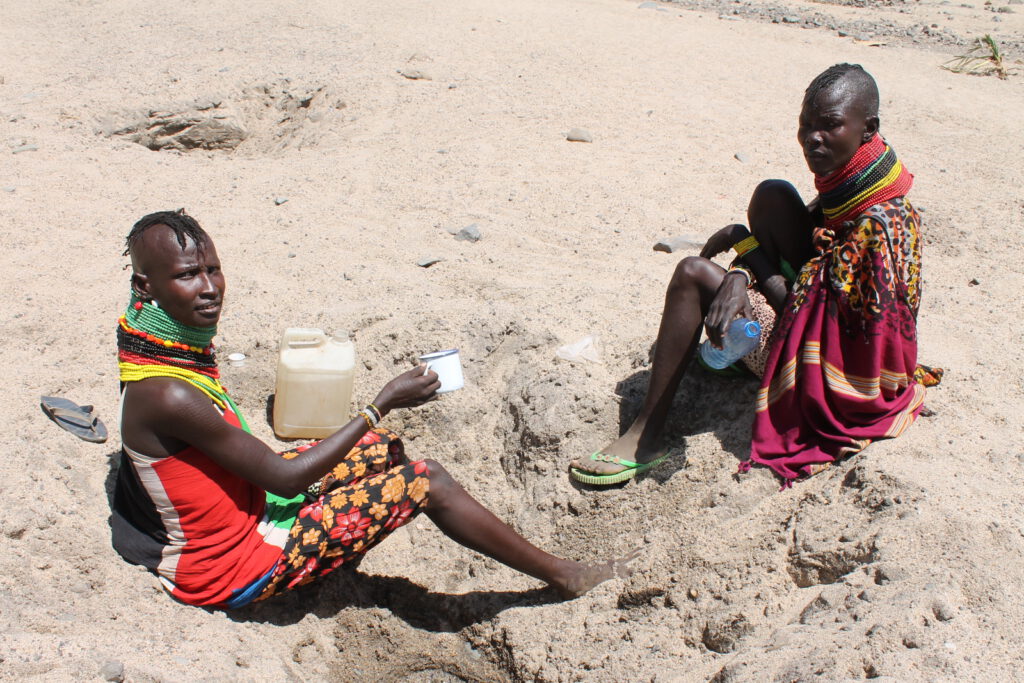by Rebecca Froese & Janpeter Schilling, both University of Koblenz-Landau
Environmental Peacebuilding connects environmental projects with peacebuilding. The German Government should recognize this potential to overcome common challenges such as climate change.
A well-known saying goes: “Give a man a fish, and you feed him for a day. Teach a man to fish and you feed him for life.” However, help for self-help only works as long as the resources and basic structures are in place. But what happens when the lake dries up? In this situation, if you ask political decision makers, a violent conflict seems likely. For in political circles, as well as in the German Government’s guidelines on crisis prevention, climate change and the associated environmental changes are increasingly being seen as a risk to human well-being and peace.
Environmental changes can exacerbate conflicts, but also promote cooperation

The German Government has correctly recognized that the deterioration of the environment and of natural resources due to climate change poses a risk to peace. However, this viewpoint is one-sided because environmental problems aggravated or triggered by climate change can also be seen as a common challenge and thus have a positive impact on cooperation and peace. The latter is called Environmental Peacebuilding and is defined by the United Nations Environment Program as the “process of governing and managing natural resources and the environment to support durable peace.” Environmental Peacebuilding can be divided into two types: first, peace as the main objective, i.e., environmental projects explicitly designed to promote sustainable peace; second, peace as a side effect, i.e., measures in environmental cooperation become unifying elements and thereby contribute to peace.
Examples demonstrate: Environmental Peacebuilding can work
The example of transboundary rivers and lakes shows that cooperation between states is the rule, and although warnings of wars over water are often issued, these have so far remained the exception. A good example of “peace as the main objective” is the “Good Water Neighbors” project in Israel/Palestine. In the project, implemented by EcoPeace Middle East, communities from Israel, the West Bank, the Gaza Strip, and Jordan worked together tackling the problem of water shortage and preserving local water resources. An example of this cooperation is the sub-committee on the rehabilitation of the Jordan River, which was created within the joint Israeli-Jordanian water committee. At the same time, various measures were taken to increase mutual trust and understanding. The project is also considered successful because collaboration at the municipal level has ultimately led to cooperation on water management at the intergovernmental level. For example, in 2013, Israel released fresh water from the Sea of Galilee into the Lower Jordan River for the first time in 49 years.
An example of “peace as a side effect” is the “Buena Milpa” project in Guatemala, which shows that Environmental Peacebuilding is not only a concept for crisis prevention, but can also have an active peacebuilding effect. The project reintroduces traditional drought- and pest-resistant maize varieties as a measure to adapt to climate change and to strengthen local institutions, such as a seed bank to manage agrobiodiversity. In a society torn apart by decades of violent conflict, networking of local agents within the wider institutional governance framework has led both to successful implementation of climate adaptation measures and to attempts of reducing mutual distrust between the involved communities.
Integrating Environmental Peacebuilding across-departments
German policy has failed to understand environmental issues as peacebuilding opportunities
The approach of Environmental Peacebuilding has so far found its way neither into German foreign and security policy nor into environmental, economic, or development policy. This is a missed opportunity. Although the Government’s interdepartmental guidelines on crises, conflicts, and peacebuilding warn against climate change as a risk intensifier, they fail to understand environmental issues as peacebuilding opportunities. Environmental Peacebuilding offers the potential to break up the purely negative narratives of “crisis prevention” and expand them to include peacebuilding. This is particularly relevant in projects with peace as a main objective, where crisis prevention is often based on so-called “negative peace,” i.e., the simple absence of violence. Environmental Peacebuilding can build on this approach and promote additional trust and thus more long-term and sustainable peace. In the words of Thomas L. Friedman: “The only source of lasting security is […] relationships of trust between neighbors that create healthy interdependencies – ecological and political. They are the hardest things to build, but also the hardest things to break once in place.” In concrete terms, this entails that the German Government incorporates Environmental Peacebuilding across all departments.
Coming back to the metaphor, introduced earlier: If the sea dries up, the fisherman has two options: Either he searches an alternative livelihood, potentially using force and triggering a chain of violence. Alternatively, all those involved see the decline of the water level as a common challenge and develop strategies to overcome the scarcity of resources for the benefit of all, thereby strengthening their relationships.
Taking a critical look at Environmental Peacebuilding
Environmental Peacebuilding introduces a change of perspective away from the perception of environmental changes as inevitable intensifiers of conflict to an opportunity for trust-building and cooperation. Nevertheless, the approach should not be seen as a panacea. Like any project in the field of development cooperation, environmental protection, and crisis prevention, Environmental Peacebuilding measures can also lead to depoliticization, discrimination, delegitimization of states, and displacement of local communities. For example, the Cordillera del Cóndor Peace Park was set up in 1998 to support demilitarization and trust-building between Ecuador and Peru. The park overlaps with the territories of the local indigenous population but was demarcated without their consultation. As a result, the people lost (legal) access to areas where they collected food, wood, and medicinal plants. This discrimination against the indigenous population by the state led to local resistance, weakened the legitimacy of the state, and endangered the livelihood of the local population.
Promoting Environmental Peacebuilding during the German EU Council Presidency

Environmental Peacebuilding should therefore be applied in an integrated and context-specific manner. If this is successful, Environmental Peacebuilding contributes to environmental protection and promotes peaceful and cooperative relations. For Germany’s forthcoming EU Council Presidency this would mean that Germany advocates strengthening civil crisis prevention, peacebuilding, and human rights, explicitly including Environmental Peacebuilding. Specifically, resources for the prevention and resolution of civil violence in the EU’s multiannual financial framework (MFF) (2021-2027) should not be reduced and replaced by massive investments in security and defense, as currently planned. Peace as a side effect can also be considered in the European Green Deal and in the MFF Article on Natural Resources and the Environment.
Similar to the concept of environmental security, Environmental Peacebuilding can establish environmental protection as an increasingly desirable cross-border and, thus, unifying objective and give it a firm place in the EU’s cohesion policy. A good example is the EU Danube Transboundary Program, which has strengthened economic, social, and territorial cohesion with measures for sustainable and integrative economic activity as well as environmental management in post-conflict societies in Eastern Europe. Supporting the EU cohesion policy seems especially appropriate in times of growing populism within the EU. The orientation of the European Peace Facility (EPF) towards military or defense policy priorities is questionable; the prevention of civil violence and the peace-promoting potential of environmental measures should also be considered. Similarly, Germany can use its current membership of the United Nations Security Council to present climate change not only as a driver of conflict, but as a common challenge and opportunity for Environmental Peacebuilding at the global level.
This is a revised version of our article in the PeaceLab blog.
Rebecca Froese is a research fellow at the Institute of Environmental Sciences in the Research Group Landuse Conflicts and at the Peace Academy Rhineland-Palatinate at University of Koblenz-Landau. Her research focuses on human-environment interactions, climate and environmental change, and environmental governance. For her dissertation she is pursuing a comparative governance analysis in the environmental sector and an analysis of land use conflicts at the tri-national border of Brazil, Bolivia and Peru.


Janpeter Schilling holds a Klaus Töpfer Junior Professorship for Landuse Conflicts at the University of Koblenz-Landau. He is also the Scientific Director of the Peace Academy Rhineland-Palatinate and a member of the editorial board of this blog. His research focuses on conflict, resources and resilience.
